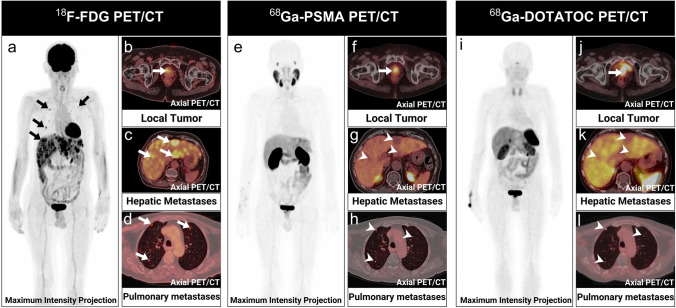Abstract
Molecular imaging is an important tool for evaluating patients with prostate cancer, including those with hybrid histopathology. Although rare, mixed small neuroendocrine tumor/acinar adenocarcinoma exhibit aggressive behavior that necessitates optimal therapy. Molecular imaging has been implemented previously to assess radioligand therapy eligibility in such cases. Interestingly, the uptake of radiotracers targeting prostate-specific membrane antigen (PSMA) and somatostatin receptor may be reduced and can potentially lead to false negative readings in certain tumor types with hybrid features. Therefore, physicians should be aware of different kinds of disparities when assessing these tumor types with the aforementioned modalities.
Keywords: Neuroendocrine prostatic cancers, FDG, PSMA, DOTATOC, Molecular imaging
Fig. 1
Fig. 1.
A 72-year-old male patient with advanced prostatic acinar adenocarcinoma was diagnosed in 2019. His baseline prostate-specific antigen (PSA) level was 700 ng/ml (normal > 4.0). The patient was managed with androgen deprivation therapy for the following 2 years. Afterwards, pelvic computed tomography (CT) imaging showed prostate enlargement despite having normal PSA levels of 0.7 ng/ml. A transurethral resection of prostate biopsy of the prostate revealed mixed small-cell neuroendocrine carcinoma and acinar adenocarcinoma. A baseline fluorodeoxyglucose positron emission tomography/CT (FDG PET/CT) was performed for staging purposes and revealed a focal hypermetabolic lesion in the right transitional zone of the prostate. Multi-disciplinary clinic session decided to start concurrent chemoradiation. After therapy, the patient did not respond well. A follow-up FDG PET/CT (a–d) showed significant disease progression, reflected by an unchanged primary tumor and the development of metastatic pulmonary and liver lesions (arrows). Therefore, 68Galium-PSMA (68Ga-PSMA) PET/CT (e–h) and 68Ga-DOTATOC PET/CT (i–l) were ordered to determine patient eligibility for lutetium therapy. These imaging modalities show limited radioligand therapy response. The last two modalities showed local and equivalent avidity at the prostate (arrows), with otherwise non-avid metastatic lesions elsewhere (arrow-heads). It’s well known that neuroendocrine prostatic cancers are extremely rare compared to prostate adenocarcinoma [1–3]. De novo or disease-related, these tumors usually have negative PSA levels [4, 5]. It is advisable to assess cases of this nature using triple PET modalities in order to determine therapy eligibility and create an optimal plan [6–9]. This picture reflects the aim to predict different patterns of expression when assessing such cases with triple modalities.
Author Contribution
Akram Al-Ibraheem and Ahmed Saad Abdlkadir participated in data acquisition and data analysis. Dhuha Ali Al-Adhami participated in initial drafting of the manuscript and data acquisition. Akram Al-Ibraheem, Nabeela Al-Hajaj, Rami Ghanem, Ramiz Abu-Hijlih, and Samer Salah participated in the study conception and design, data analysis, manuscript revision, and approval of the final content of the manuscript. All authors read and approved the final manuscript.
Data Availability
The current study data are available from the corresponding author on reasonable request.
Compliance with Ethical Standards
Conflict of Interest
Akram Al-Ibraheem, Dhuha Ali Al-Adhami, Ahmed Saad Abdlkadir, Nabeela Al-Hajaj, Rami Ghanem, Ramiz Abu-Hijlih, and Samer Salah declare that they have no conflict of interest.
Ethics Approval
All procedures performed in studies involving human participants were in accordance with the ethical standards of the institutional and/or national research committee and with the 1964 Helsinki declaration and its later amendments or comparable ethical standards.
Consent to Participate
Informed consent was obtained from the patient.
Consent for Publication
Not applicable.
Footnotes
Publisher's Note
Springer Nature remains neutral with regard to jurisdictional claims in published maps and institutional affiliations.
Contributor Information
Akram Al-Ibraheem, Email: aibraheem@khcc.jo, Email: akramalibrahim@gmail.com.
Dhuha Ali Al-Adhami, Email: duha92ali@hotmail.com.
Ahmed Saad Abdlkadir, Email: ahmedshukri92@hotmail.com.
Nabeela Al-Hajaj, Email: na.13800@khcc.jo.
Rami Ghanem, Email: rghanem@khcc.jo.
Ramiz Abu-Hijlih, Email: rhijlih@khcc.jo.
Samer Salah, Email: ds.06907@khcc.jo.
References
- 1.Guo A, Wen S, Ma Y, Wei L, Liu A. Clinicopathological analysis on small cell carcinoma of the prostate in Chinese patients. J Cancer. 2014;5:797–803. doi: 10.7150/jca.9388. [DOI] [PMC free article] [PubMed] [Google Scholar]
- 2.Capizzello A, Peponi E, Simou N, Ntaskagiannis D, Tasiou I, Kamina S, et al. Pure small cell carcinoma of the prostate: a case report and literature review. Case Rep Oncol. 2011;4:88–95. doi: 10.1159/000324717. [DOI] [PMC free article] [PubMed] [Google Scholar]
- 3.Pokhrel A, Nair K, Jaswani V, Salyana M, Mooppan U, Wang JC. Review of checkpoint inhibitor immunotherapy in neuroendocrine tumor of prostate and our experience in 2 cases. J Investig Med High Impact Case Rep. 2022;10:232470962210938. doi: 10.1177/23247096221093886. [DOI] [PMC free article] [PubMed] [Google Scholar]
- 4.Miyoshi Y, Uemura H, Kitami K, Satomi Y, Kubota Y, Hosaka M. Neuroendocrine differentiated small cell carcinoma presenting as recurrent prostate cancer after androgen deprivation therapy. BJU Int. 2001;88:982–983. doi: 10.1046/j.1464-4096.2001.00936.x. [DOI] [PubMed] [Google Scholar]
- 5.Hingorani R, Young J, Alweis R. Mixed adenocarcinoma and neuroendocrine prostate cancer: a case report. J Community Hosp Intern Med Perspect. 2014;4:25176. doi: 10.3402/jchimp.v4.25176. [DOI] [PMC free article] [PubMed] [Google Scholar]
- 6.Sharma R, Wang WM, Yusuf S, Evans J, Ramaswami R, Wernig F, et al. 68Ga-DOTATATE PET/CT parameters predict response to peptide receptor radionuclide therapy in neuroendocrine tumours. Radiother Oncol. 2019;141:108–115. doi: 10.1016/j.radonc.2019.09.003. [DOI] [PubMed] [Google Scholar]
- 7.Hirmas N, Jadaan R, Al-Ibraheem A. Peptide receptor radionuclide therapy and the treatment of gastroentero-pancreatic neuroendocrine tumors: current findings and future perspectives. Nucl Med Mol Imaging. 2018;52:190–199. doi: 10.1007/s13139-018-0517-x. [DOI] [PMC free article] [PubMed] [Google Scholar]
- 8.Chen S, Cheung SK, Wong K-N, Wong KK, Ho C-L. 68Ga-DOTATOC and 68Ga-PSMA PET/CT unmasked a case of prostate cancer with neuroendocrine differentiation. Clin Nucl Med. 2016;41:959–960. doi: 10.1097/RLU.0000000000001419. [DOI] [PubMed] [Google Scholar]
- 9.Luboldt W, Zöphel K, Wunderlich G, Abramyuk A, Luboldt H-J, Kotzerke J. Visualization of somatostatin receptors in prostate cancer and its bone metastases with Ga-68–DOTATOC PET/CT. Mol Imaging Biol. 2010;12:78–84. doi: 10.1007/s11307-009-0230-3. [DOI] [PubMed] [Google Scholar]
Associated Data
This section collects any data citations, data availability statements, or supplementary materials included in this article.
Data Availability Statement
The current study data are available from the corresponding author on reasonable request.



